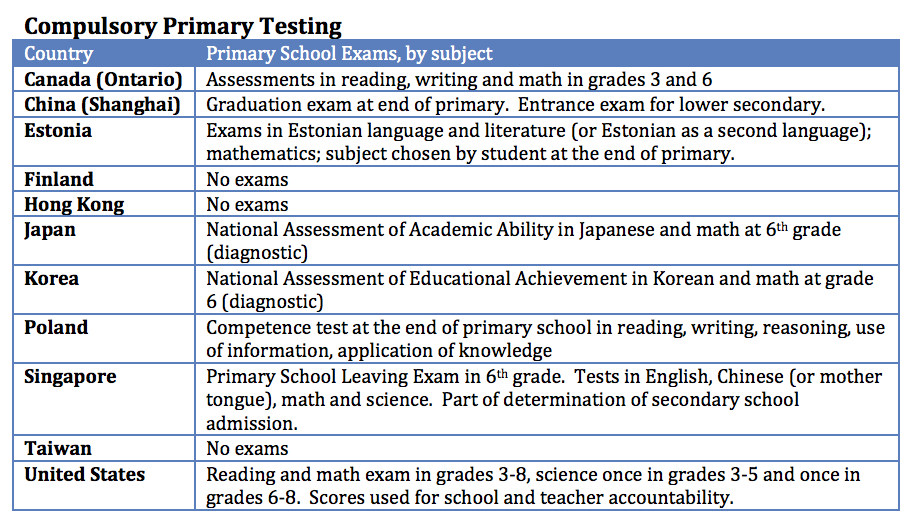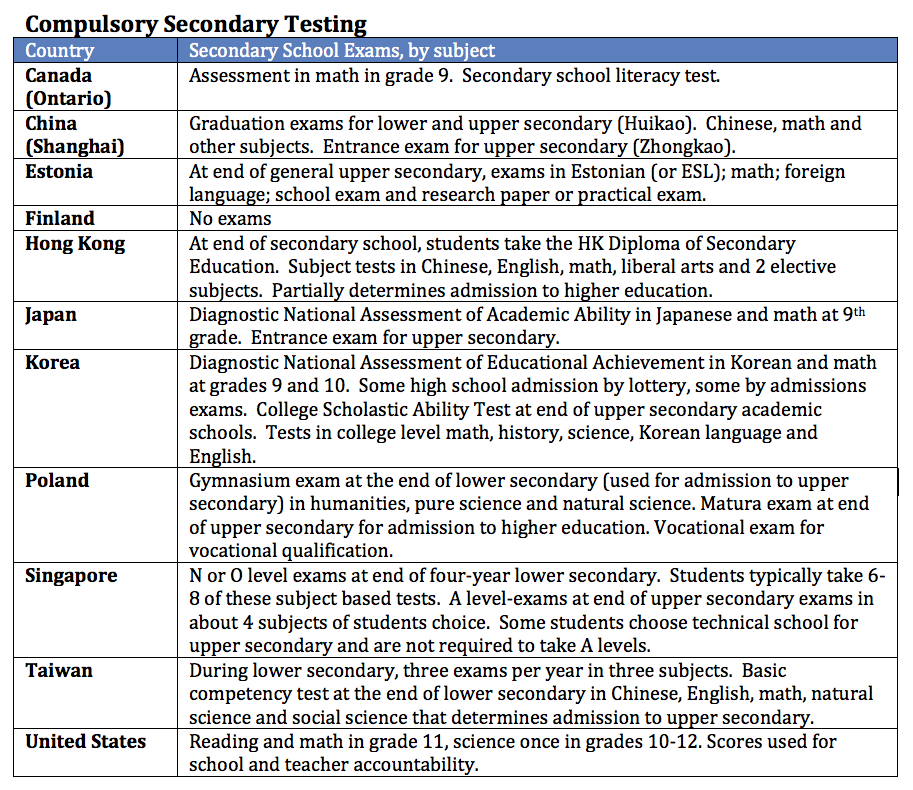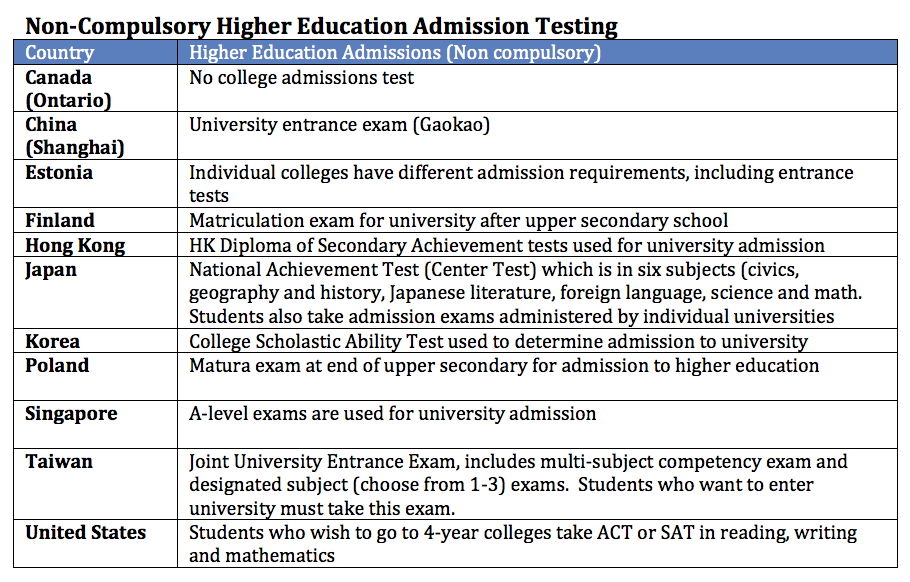This from the
Center on International Education Benchmarking:
 Unlike the top-performing countries on the 2012 PISA, the United
States stands out for the amount of external testing it requires for all
students. As the chart below shows, the United States is the only
country among this set to require annual testing in primary and middle
schools in reading and mathematics. A more typical pattern among the top-performers is a required gateway exam, or an exam that allows a
student to move on to the next phase of education, at the end of primary
school, the end of lower secondary school and the end of upper
secondary school. This is true of Canada (Ontario), China (Shanghai),
Estonia, Poland and Singapore. In some of these cases, the secondary
school exams are used to determine placement in the next level of
schooling such as in Singapore and Shanghai where the lower
school-leaving exam determines placement in upper secondary school. And
in Poland, Shanghai and Singapore the upper secondary academic exam
functions as an admission exam for university. This differs from the
United States where annual tests are used primarily for school and
teacher accountability purposes. In his edweek.org blog, NCEE President
Marc Tucker has written extensively about the challenges associated
with this type of accountability scheme. In addition to administering
census testing at only three or fewer points in a student’s school
career, the top-performers typically test a broader range of subjects
than English and mathematics, the subjects tested annually in the United
States.
Unlike the top-performing countries on the 2012 PISA, the United
States stands out for the amount of external testing it requires for all
students. As the chart below shows, the United States is the only
country among this set to require annual testing in primary and middle
schools in reading and mathematics. A more typical pattern among the top-performers is a required gateway exam, or an exam that allows a
student to move on to the next phase of education, at the end of primary
school, the end of lower secondary school and the end of upper
secondary school. This is true of Canada (Ontario), China (Shanghai),
Estonia, Poland and Singapore. In some of these cases, the secondary
school exams are used to determine placement in the next level of
schooling such as in Singapore and Shanghai where the lower
school-leaving exam determines placement in upper secondary school. And
in Poland, Shanghai and Singapore the upper secondary academic exam
functions as an admission exam for university. This differs from the
United States where annual tests are used primarily for school and
teacher accountability purposes. In his edweek.org blog, NCEE President
Marc Tucker has written extensively about the challenges associated
with this type of accountability scheme. In addition to administering
census testing at only three or fewer points in a student’s school
career, the top-performers typically test a broader range of subjects
than English and mathematics, the subjects tested annually in the United
States.
How tests are used is also different among the high performers.
South Korea and Japan test only for diagnostic purposes in the primary
schools, and South Korea continues to test for diagnostic purposes
through 10th grade. It is at the secondary level that they introduce
the high stakes exams for students, with Japanese students required to
take an entrance exam for upper secondary school and students in both
countries required to take tests at the end of upper secondary school
that will determine what kind of higher education institution they can
enter. These tests are recognized as very high pressure for students
and both countries are trying to address that issue. In both Korea and
Japan, some students enter a vocational training system at the upper
secondary level and take tests to qualify for vocational credentials
rather than the tests for entry into university.
Hong Kong and Finland have no required testing until the end of upper
secondary school. Taiwan is a bit of a hybrid, with no required
testing in primary school, but a Basic Competency Test at the end of
lower secondary (along with three required tests a year in each of three
subjects during lower secondary) that determines admission to upper
secondary school.
Below are three charts showing the required testing in the United
States and the ten top-performing countries on PISA at the primary and
secondary levels, as well as a chart of exams required for those who
wish to enter higher education.



As the United States embarks on
implementing tests to measure students’ mastery of the Common Core State
Standards, it would be wise to keep in mind these very different models
of not only test schedules, but format and purpose. The tests in the
top-performing countries come at key gateways when students advance from
one school to another and have a purpose that is clearly understood by
students, parents and teachers. While we do not advocate using tests to
track students into particular vocational or academic pathways, placing
stakes on the exams for students certainly impacts how hard they work
in school.
Unlike the top-performing countries on the 2012 PISA, the United States stands out for the amount of external testing it requires for all students. As the chart below shows, the United States is the only country among this set to require annual testing in primary and middle schools in reading and mathematics. A more typical pattern among the top-performers is a required gateway exam, or an exam that allows a student to move on to the next phase of education, at the end of primary school, the end of lower secondary school and the end of upper secondary school. This is true of Canada (Ontario), China (Shanghai), Estonia, Poland and Singapore. In some of these cases, the secondary school exams are used to determine placement in the next level of schooling such as in Singapore and Shanghai where the lower school-leaving exam determines placement in upper secondary school. And in Poland, Shanghai and Singapore the upper secondary academic exam functions as an admission exam for university. This differs from the United States where annual tests are used primarily for school and teacher accountability purposes. In his edweek.org blog, NCEE President Marc Tucker has written extensively about the challenges associated with this type of accountability scheme. In addition to administering census testing at only three or fewer points in a student’s school career, the top-performers typically test a broader range of subjects than English and mathematics, the subjects tested annually in the United States.



1 comment:
This is a story about a charter school that might lose it's charter. So why do I say it's why charter schools are a good thing? Because public schools which aren't serving their students never get threatened with shutdown. This one may be closed. That is a good thing. It's also a cautionary tale to those of you with kids in the charter system that you must always pay attention to what's going on in your school.
http://gazette.com/review-team-recommends-closure-of-colorado-springs-charter-school/article/1544626
Post a Comment